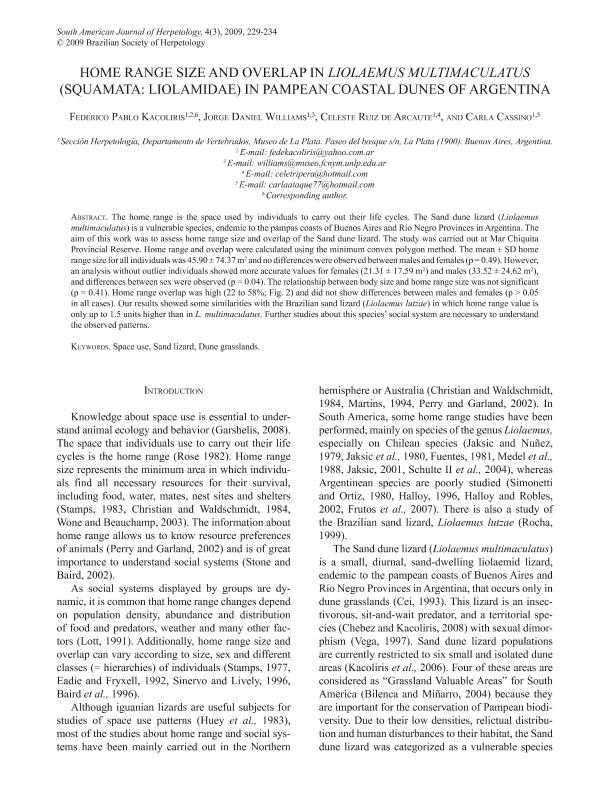Artículo
Home range size and overlap in Liolaemus multimaculatus (Squamata: Liolamidae) in pampean coastal dunes of Argentina
Kacoliris, Federico Pablo ; Williams, Jorge Daniel
; Williams, Jorge Daniel ; Ruiz de Arcaute, Celeste
; Ruiz de Arcaute, Celeste ; Cassino, Carla Corina
; Cassino, Carla Corina
 ; Williams, Jorge Daniel
; Williams, Jorge Daniel ; Ruiz de Arcaute, Celeste
; Ruiz de Arcaute, Celeste ; Cassino, Carla Corina
; Cassino, Carla Corina
Fecha de publicación:
12/2009
Editorial:
Brazilian Society of Herpetology
Revista:
South American Journal of Herpetology
ISSN:
1808-9798
e-ISSN:
1937-2418
Idioma:
Inglés
Tipo de recurso:
Artículo publicado
Clasificación temática:
Resumen
The home range is the space used by individuals to carry out their life cycles. The Sand dune lizard (Liolaemus multimaculatus) is a vulnerable species, endemic to the pampas coasts of Buenos Aires and Río Negro Provinces in Argentina. The aim of this work was to assess home range size and overlap of the Sand dune lizard. The study was carried out at Mar Chiquita Provincial Reserve. Home range and overlap were calculated using the minimum convex polygon method. The mean ± SD home range size for all individuals was 45.90 ± 74.37 m2 and no differences were observed between males and females (p = 0.49). However, an analysis without outlier individuals showed more accurate values for females (21.31 ± 17.59 m2) and males (33.52 ± 24.62 m2), and differences between sex were observed (p = 0.04). The relationship between body size and home range size was not significant (p = 0.41). Home range overlap was high (22 to 58%; Fig. 2) and did not show differences between males and females (p > 0.05 in all cases). Our results showed some similarities with the Brazilian sand lizard (Liolaemus lutzae) in which home range value is only up to 1.5 units higher than in L. multimaculatus. Further studies about this species? social system are necessary to understand the observed patterns.
Palabras clave:
Space Use
,
Sand Lizard
,
Dune Grasslands
Archivos asociados
Licencia
Identificadores
Colecciones
Articulos(CCT - LA PLATA)
Articulos de CTRO.CIENTIFICO TECNOL.CONICET - LA PLATA
Articulos de CTRO.CIENTIFICO TECNOL.CONICET - LA PLATA
Articulos(CCT - NOA SUR)
Articulos de CTRO.CIENTIFICO TECNOL.CONICET - NOA SUR
Articulos de CTRO.CIENTIFICO TECNOL.CONICET - NOA SUR
Citación
Kacoliris, Federico Pablo; Williams, Jorge Daniel; Ruiz de Arcaute, Celeste; Cassino, Carla Corina; Home range size and overlap in Liolaemus multimaculatus (Squamata: Liolamidae) in pampean coastal dunes of Argentina; Brazilian Society of Herpetology; South American Journal of Herpetology; 4; 3; 12-2009; 229-234
Compartir
Altmétricas



